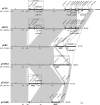Complete nucleotide sequence and comparative analysis of pPR9, a 41.7-kilobase conjugative staphylococcal multiresistance plasmid conferring high-level mupirocin resistance
- PMID: 20211895
- PMCID: PMC2863664
- DOI: 10.1128/AAC.01074-09
Complete nucleotide sequence and comparative analysis of pPR9, a 41.7-kilobase conjugative staphylococcal multiresistance plasmid conferring high-level mupirocin resistance
Abstract
We have sequenced the conjugative plasmid pPR9, which carries the ileS2 gene, which had contributed to the dissemination of high-level mupirocin resistance at our institution. The plasmid backbone shows extensive genetic conservation with plasmids belonging to the pSK41/pGO1 family, but comparative analyses have revealed key differences that provide important insights into the evolution of these medically important plasmids and high-level mupirocin resistance in staphylococci and highlight the role of insertion sequence IS257 in these processes.
Figures



Similar articles
-
Transfer of mupirocin resistance from Staphylococcus haemolyticus clinical strains to Staphylococcus aureus through conjugative and mobilizable plasmids.FEMS Microbiol Lett. 2016 Jul;363(14):fnw121. doi: 10.1093/femsle/fnw121. Epub 2016 May 4. FEMS Microbiol Lett. 2016. PMID: 27190144
-
Co-transfer of plasmids in association with conjugative transfer of mupirocin or mupirocin and penicillin resistance in methicillin-resistant Staphylococcus aureus.J Med Microbiol. 2000 Dec;49(12):1103-1107. doi: 10.1099/0022-1317-49-12-1103. J Med Microbiol. 2000. PMID: 11129723
-
Biology of the staphylococcal conjugative multiresistance plasmid pSK41.Plasmid. 2013 Jul;70(1):42-51. doi: 10.1016/j.plasmid.2013.02.001. Epub 2013 Feb 13. Plasmid. 2013. PMID: 23415796 Review.
-
Characterization of a conjugative staphylococcal mupirocin resistance plasmid.Antimicrob Agents Chemother. 1995 Jun;39(6):1272-80. doi: 10.1128/AAC.39.6.1272. Antimicrob Agents Chemother. 1995. PMID: 7574515 Free PMC article.
-
Mupirocin resistance.Clin Infect Dis. 2009 Sep 15;49(6):935-41. doi: 10.1086/605495. Clin Infect Dis. 2009. PMID: 19673644 Review.
Cited by
-
The Plasmidomic Landscape of Clinical Methicillin-Resistant Staphylococcus aureus Isolates from Malaysia.Antibiotics (Basel). 2023 Apr 9;12(4):733. doi: 10.3390/antibiotics12040733. Antibiotics (Basel). 2023. PMID: 37107095 Free PMC article.
-
Replication of Staphylococcal Resistance Plasmids.Front Microbiol. 2017 Nov 23;8:2279. doi: 10.3389/fmicb.2017.02279. eCollection 2017. Front Microbiol. 2017. PMID: 29218034 Free PMC article. Review.
-
Mobile Genetic Elements Associated with Antimicrobial Resistance.Clin Microbiol Rev. 2018 Aug 1;31(4):e00088-17. doi: 10.1128/CMR.00088-17. Print 2018 Oct. Clin Microbiol Rev. 2018. PMID: 30068738 Free PMC article. Review.
-
Comparison of antibiotic resistance, biofilm formation and conjugative transfer of Staphylococcus and Enterococcus isolates from International Space Station and Antarctic Research Station Concordia.Microb Ecol. 2013 Apr;65(3):638-51. doi: 10.1007/s00248-013-0193-4. Epub 2013 Feb 15. Microb Ecol. 2013. PMID: 23411852
-
The recent emergence in hospitals of multidrug-resistant community-associated sequence type 1 and spa type t127 methicillin-resistant Staphylococcus aureus investigated by whole-genome sequencing: Implications for screening.PLoS One. 2017 Apr 11;12(4):e0175542. doi: 10.1371/journal.pone.0175542. eCollection 2017. PLoS One. 2017. PMID: 28399151 Free PMC article.
References
-
- Badger, J. H., and G. J. Olsen. 1999. CRITICA: coding region identification tool invoking comparative analysis. Mol. Biol. Evol. 16:512-524. - PubMed
-
- Berg, T. 2000. Conjugative and mobilisable antimicrobial resistance plasmids from staphylococci. Ph.D. thesis. University of Sydney, Sydney, NSW, Australia.
Publication types
MeSH terms
Substances
Associated data
- Actions
LinkOut - more resources
Full Text Sources
Medical

